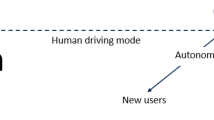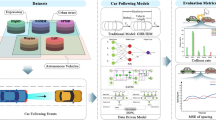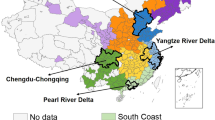Abstract
It is widely accepted that consumers underestimate the full cost of car ownership and that correcting this bias could meaningfully accelerate the adoption of shared mobility. Yet this argument fails to consider how much benefit consumers enjoy from owning their own vehicle. Here we estimate the value of private car ownership and use in four US metro areas—Chicago, Illinois; Dallas, Texas; Seattle, Washington; and Washington DC—using online discrete choice experiments. We find that, on average, people would need to be paid $11,197 to give up access to their privately owned vehicle for one year, which is at least as much as estimates of the average total private cost of vehicle ownership (~$9,000). Critically, we find that more than half of this value is non-use value—such as the option to travel whenever or wherever needed at a moment’s notice and the status that comes from owning one’s own vehicle—beyond the use value of getting from A to B. Further, this non-use value was found to be much higher during the COVID-19 pandemic. Our findings reframe the conversation around the transition away from private vehicle dependence, emphasizing the need to provide value and convenience if alternative mobility solutions are to be widely adopted.
This is a preview of subscription content, access via your institution
Access options
Access Nature and 54 other Nature Portfolio journals
Get Nature+, our best-value online-access subscription
$32.99 / 30 days
cancel any time
Subscribe to this journal
Receive 12 digital issues and online access to articles
$119.00 per year
only $9.92 per issue
Buy this article
- Purchase on SpringerLink
- Instant access to full article PDF
Prices may be subject to local taxes which are calculated during checkout

Similar content being viewed by others
Data availability
The data that support the findings of this study are available on request from the corresponding author. The data are not publicly available because they contain information that could compromise research participant privacy/consent.
Code availability
The full questionnaire, analysis code and results are available at https://github.com/jcmoody6/car-value. Correspondence and requests for materials should be addressed to the corresponding author.
References
Household, Individual, and Vehicle Characteristics (Bureau of Transportation Statistics, 2017); https://www.bts.gov/archive/publications/highlights_of_the_2001_national_household_travel_survey/section_01
Edmonds, E. 2019 Your Driving Costs: Spike in Finance Costs Drives Increase (AAA, 2019); https://newsroom.aaa.com/2019/09/your-driving-costs-spike-in-finance-costs-drives-increase/
Shaheen, S. in Three Revolutions (ed. Sperling, D.) 55–76 (Island Press, 2018).
Manville, M. & Shoup, D. Parking, people, and cities. J. Urban Plan. Dev. 131, 233–245 (2005).
Shoup, D. C. The high cost of free parking. J. Plan. Educ. Res. 17, 3–20 (1997).
Andor, M. A., Gerster, A., Gillingham, K. T. & Horvath, M. Running a car costs much more than people think—stalling the uptake of green travel. Nature 580, 453–455 (2020).
Wilhelms, M.-P., Henkel, S. & Falk, T. To earn is not enough: a means–end analysis to uncover peer-providers’ participation motives in peer-to-peer carsharing. Technol. Forecast. Soc. Change 125, 38–47 (2017).
Duncan, M. The cost saving potential of carsharing in a US context. Transportation 38, 363–382 (2011).
Shafir, E. & Thaler, R. H. Invest now, drink later, spend never: on the mental accounting of delayed consumption. J. Econ. Psychol. 27, 694–712 (2006).
Millard-Ball, A., Murray, G., Schure, J. T., Fox, C. & Burkhardt, J. Car Sharing: Where and How it Succeeds Report 108 (Transportation Research Board, 2005).
Katzev, R. Car sharing: a new approach to urban transportation problems. Anal. Soc. Issues Public Policy 3, 65–86 (2003).
Curl, A., Clark, J. & Kearns, A. Household car adoption and financial distress in deprived urban communities: a case of forced car ownership? Transp. Policy 65, 61–71 (2018).
Blumenberg, E. & Pierce, G. Car access and long-term poverty exposure: evidence from the Moving to Opportunity (MTO) experiment. J. Transp. Geogr. 65, 92–100 (2017).
Gurley, T. & Bruce, D. The effects of car access on employment outcomes for welfare recipients. J. Urban Econ. 58, 250–272 (2005).
Moody, J. & Zhao, J. Travel behavior as a driver of attitude: car use and car pride in US cities. Transp. Res. Part F 47, 225–236 (2020).
Moody, J. & Zhao, J. Car pride and its bidirectional relations with car ownership: case studies in New York City and Houston. Transp. Res. Part A 124, 334–353 (2019).
Steg, L. Car use: lust and must. Instrumental, symbolic and affective motives for car use. Transp. Res. Part A 39, 147–162 (2005).
Prettenthaler, F. E. & Steininger, K. W. From ownership to service use lifestyle: the potential of car sharing. Ecol. Econ. 28, 443–453 (1999).
Means of Transportation to Work by Vehicles Available Table B08141 (US Census Bureau, 2020); https://data.census.gov/cedsci/table?text=B08141&t=Transportation&y=2010&tid=ACSDT5Y2010.B08141&hidePreview=false
Oakil, A. T. M., Manting, D. & Nijland, H. Determinants of car ownership among young households in the Netherlands: the role of urbanisation and demographic and economic characteristics. J. Transp. Geogr. 51, 229–235 (2016).
Clark, B., Lyons, G. & Chatterjee, K. Understanding the process that gives rise to household car ownership level changes. J. Transp. Geogr. 55, 110–120 (2016).
Bhat, C. R. & Guo, J. Y. A comprehensive analysis of built environment characteristics on household residential choice and auto ownership levels. Transp. Res. Part B 41, 506–526 (2007).
Axsen, J., Plötz, P. & Wolinetz, M. Crafting strong, integrated policy mixes for deep CO2 mitigation in road transport. Nat. Clim. Change 10, 809–818 (2020).
Stevens, M. R. Does compact development make people drive less? J. Am. Plan. Assoc. 83, 7–18 (2017).
Guo, Z. Does residential parking supply affect household car ownership? The case of New York City. J. Transp. Geogr. 26, 18–28 (2013).
Buehler, R. Transport policies, automobile use, and sustainable transport: a comparison of Germany and the United States. J. Plan. Educ. Res. 30, 76–93 (2010).
Shoup, D. C. The ideal source of local public revenue. Reg. Sci. Urban Econ. 34, 753–784 (2004).
Ho, C. Q., Hensher, D. A., Mulley, C. & Wong, Y. Z. Potential uptake and willingness-to-pay for mobility as a service (MaaS): a stated choice study. Transp. Res. Part A 117, 302–318 (2018).
Hjorthol, R. Decreasing popularity of the car? Changes in driving licence and access to a car among young adults over a 25-year period in Norway. J. Transp. Geogr. 51, 140–146 (2016).
McDonald, N. C. Are Millennials really the ‘go-nowhere’ generation? J. Am. Plan. Assoc. 81, 90–103 (2015).
Delbosc, A. & Currie, G. Causes of youth licensing decline: a synthesis of evidence. Transp. Rev. 33, 271–290 (2013).
Kuhnimhof, T., Buehler, R. & Dargay, J. A new generation: travel trends for young Germans and Britons. Transp. Res. Rec. 1989, 58–67 (2011).
Etezady, A., Shaw, F. A., Mokhtarian, P. L. & Circella, G. What drives the gap? Applying the Blinder–Oaxaca decomposition method to examine generational differences in transportation-related attitudes. Transportation https://doi.org/10.1007/s11116-020-10080-5 (2020).
Knittel, C. & Murphy, E. Generational Trends in Vehicle Ownership and Use: Are Millennials Any Different? Working Paper 25674 (National Bureau of Economic Research, 2019); https://doi.org/10.3386/w25674
Kurz, C., Li, G. & Vine, D. J. 2018. Are Millennials Different? Finance and Economics Discussion Series 2018-080 (Board of Governors of the Federal Reserve System, 2018); https://doi.org/10.17016/FEDS.2018.080
Klein, N. J. & Michael, J. S. Millennials and car ownership: less money, fewer cars. Transp. Policy 53, 20–29 (2017).
Lyons, G., Hammond, P. & Mackay, K. The importance of user perspective in the evolution of MaaS. Transp. Res. Part A 121, 22–36 (2019).
Mulley, C. Mobility as a service (MaaS)—does it have critical mass? Transp. Rev. 37, 247–251 (2017).
Jittrapirom, P. et al. Mobility as a service: a critical review of definitions, assessments of schemes, and key challenges. Urban Plan. 2, 13–25 (2017).
Eckhardt, J., Aapaoja, A., Nykänen, L. & Sochor, J. Mobility as a service business and operator models. In Proc. 12th ITS European Congress 19–22 (2017).
Bansal, P., Sinha, A., Dua, R. & Daziano, R. A. Eliciting preferences of TNC users and drivers: evidence from the United States. Travel Behav. Soc. 20, 225–236 (2020).
Schaller, B. The New Automobility: Lyft, Uber, and the Future of American Cities (Schaller Consulting, 2018); http://www.schallerconsult.com/rideservices/automobility.htm
Hampshire, R. C., Simek, C., Fabusuyi, T., Di, X. & Chen, X. Measuring the impact of an unanticipated suspension of ride-sourcing in Austin, Texas. SSRN Electron. J. (2017).
Gehrke, S. R., Felix, A. & Reardon, T. Fare Choices: A Survey of Ride-Hailing Passengers in Metro Boston (Metropolitan Area Planning Council, 2018); https://www.mapc.org/farechoices/
Rayle, L., Dai, D., Chan, N., Cervero, R. & Shaheen, S. Just a better taxi? A survey-based comparison of taxis, transit, and ridesourcing services in San Francisco. Transp. Policy 45, 168–178 (2016).
Diao, M., Kong, H. & Zhao, J. Impacts of transportation network companies on urban mobility. Nat. Sustain. https://doi.org/10.1038/s41893-020-00678-z (2021).
Knetsch, J. L. The endowment effect and evidence of nonreversible indifference curves. Am. Econ. Rev. 79, 1277–1284 (1989).
Ashmore, D. P., Thoreau, R., Kwami, C., Christie, N. & Tyler, N. A. Using thematic analysis to explore symbolism in transport choice across national cultures. Transportation 47, 607–640 (2020).
Klinger, T. & Lanzendorf, M. Moving between mobility cultures: what affects the travel behavior of new residents? Transportation 43, 243–271 (2016).
Guidon, S., Wicki, M., Bernauer, T. & Axhausen, K. Transportation service—for whose benefit? Consumer valuation of pure bundling in the passenger transportation market. Transp. Res. Part A 131, 91–106 (2020).
Loomis, J., Peterson, G., Champ, P., Brown, T. & Lucero, B. Paired comparison estimates of willingness to accept versus contingent valuation estimates of willingness to pay. J. Econ. Behav. Organ. 35, 501–515 (1998).
Louviere, J., Lings, I., Islam, T., Gudergan, S. & Flynn, T. An introduction to the application of (case 1) best–worst scaling in marketing research. Int. J. Res. Mark. 30, 292–303 (2013).
Brynjolfsson, E., Collis, A. & Eggers, F. Using massive online choice experiments to measure changes in well-being. Proc. Natl Acad. Sci. USA 116, 7250–7255 (2019).
Louviere, J. J., Flynn, T. N. & Marley, A. A. J. Best–Worst Scaling: Theory, Methods and Applications (Cambridge Univ. Press, 2015).
Acknowledgements
This research was funded by an MIT Energy Initiative’s Mobility Systems Center project grant awarded to D.R.K. and J.M.
Author information
Authors and Affiliations
Contributions
J.M. and D.R.K. developed the original research question; J.M., E.F. and D.R.K. designed the questionnaire and stated preference experiments; J.M., E.F. and M.P. oversaw data collection and undertook data analysis; J.M., E.F. and D.R.K. wrote and revised the manuscript.
Corresponding author
Ethics declarations
Competing interests
The authors declare no competing interests.
Additional information
Peer review information Nature Sustainability thanks Sonja Haustein, Rico Krueger and the other, anonymous, reviewer(s) for their contribution to the peer review of this work.
Publisher’s note Springer Nature remains neutral with regard to jurisdictional claims in published maps and institutional affiliations.
Supplementary information
Supplementary Information
Supplementary discussion, Figs. 1–10 and Tables 1–7.
Rights and permissions
About this article
Cite this article
Moody, J., Farr, E., Papagelis, M. et al. The value of car ownership and use in the United States. Nat Sustain 4, 769–774 (2021). https://doi.org/10.1038/s41893-021-00731-5
Received:
Accepted:
Published:
Issue date:
DOI: https://doi.org/10.1038/s41893-021-00731-5
This article is cited by
-
Electrification pathways for U.S. passenger vehicles
npj Sustainable Mobility and Transport (2025)
-
Electric vehicles limit equitable access to essential services during blackouts
npj Sustainable Mobility and Transport (2024)
-
AI-generated visuals of car-free US cities help improve support for sustainable policies
Nature Sustainability (2024)
-
Energy and environmental impacts of shared autonomous vehicles under different pricing strategies
npj Urban Sustainability (2023)
-
Exploring decarbonization pathways for USA passenger and freight mobility
Nature Communications (2023)



